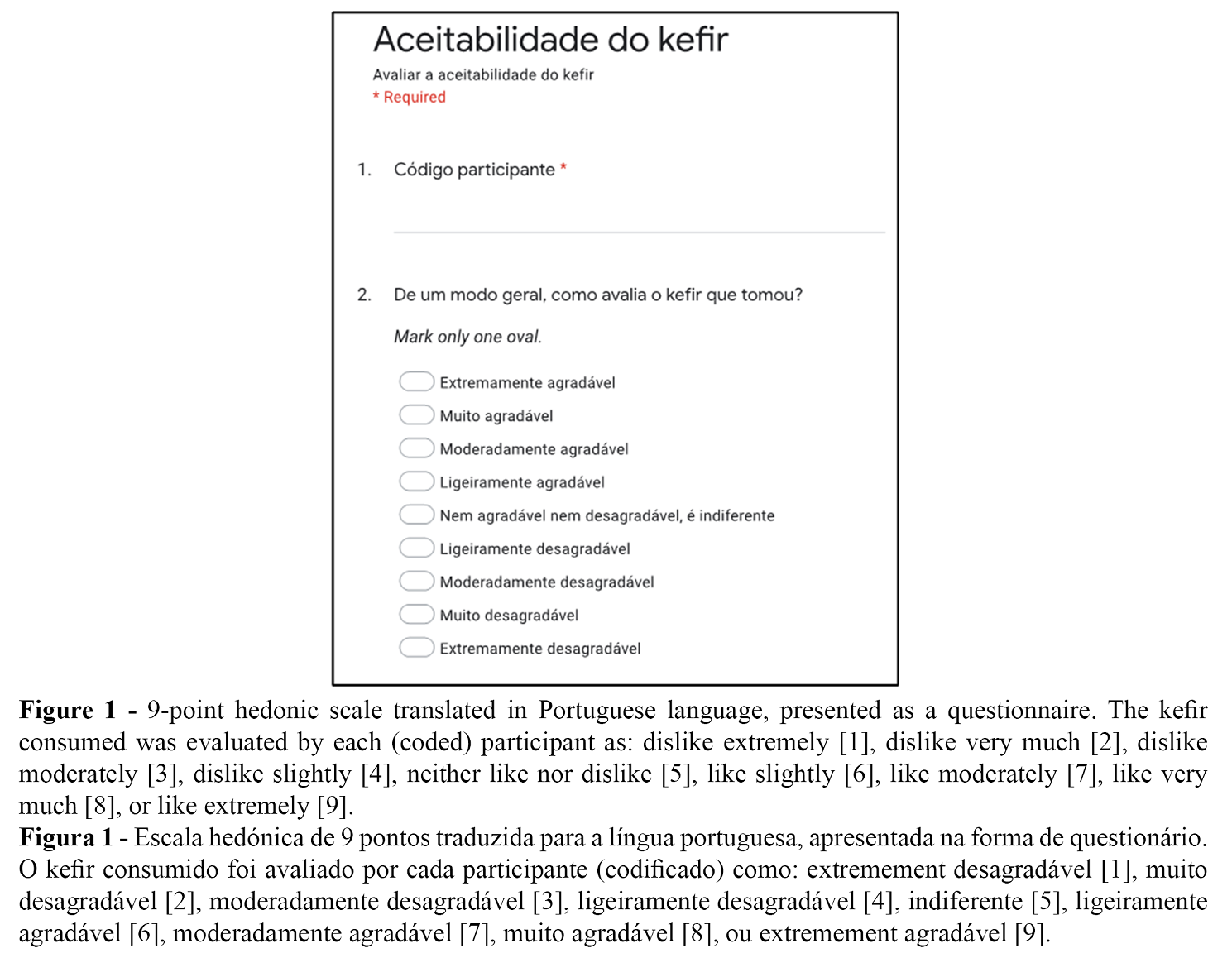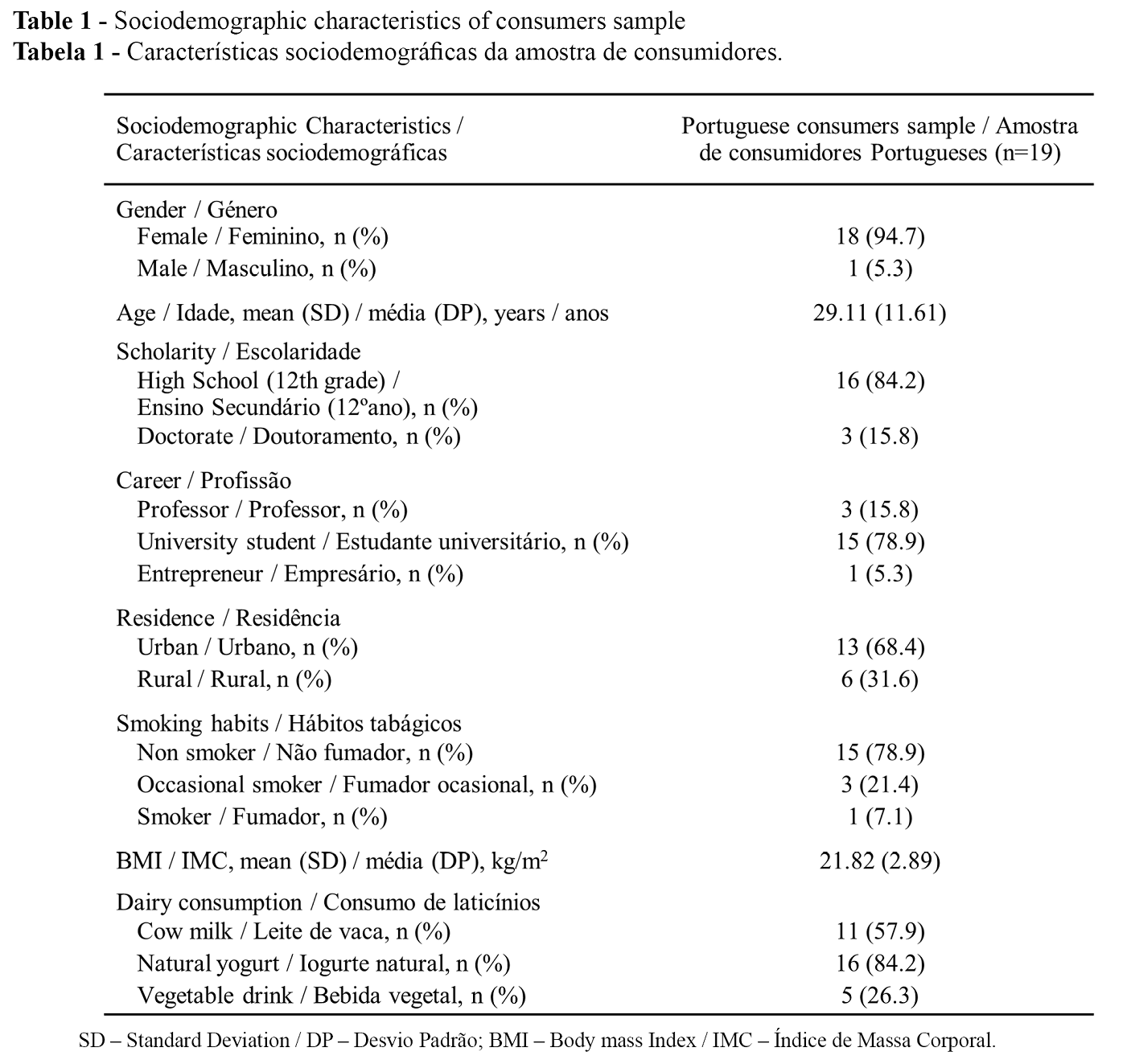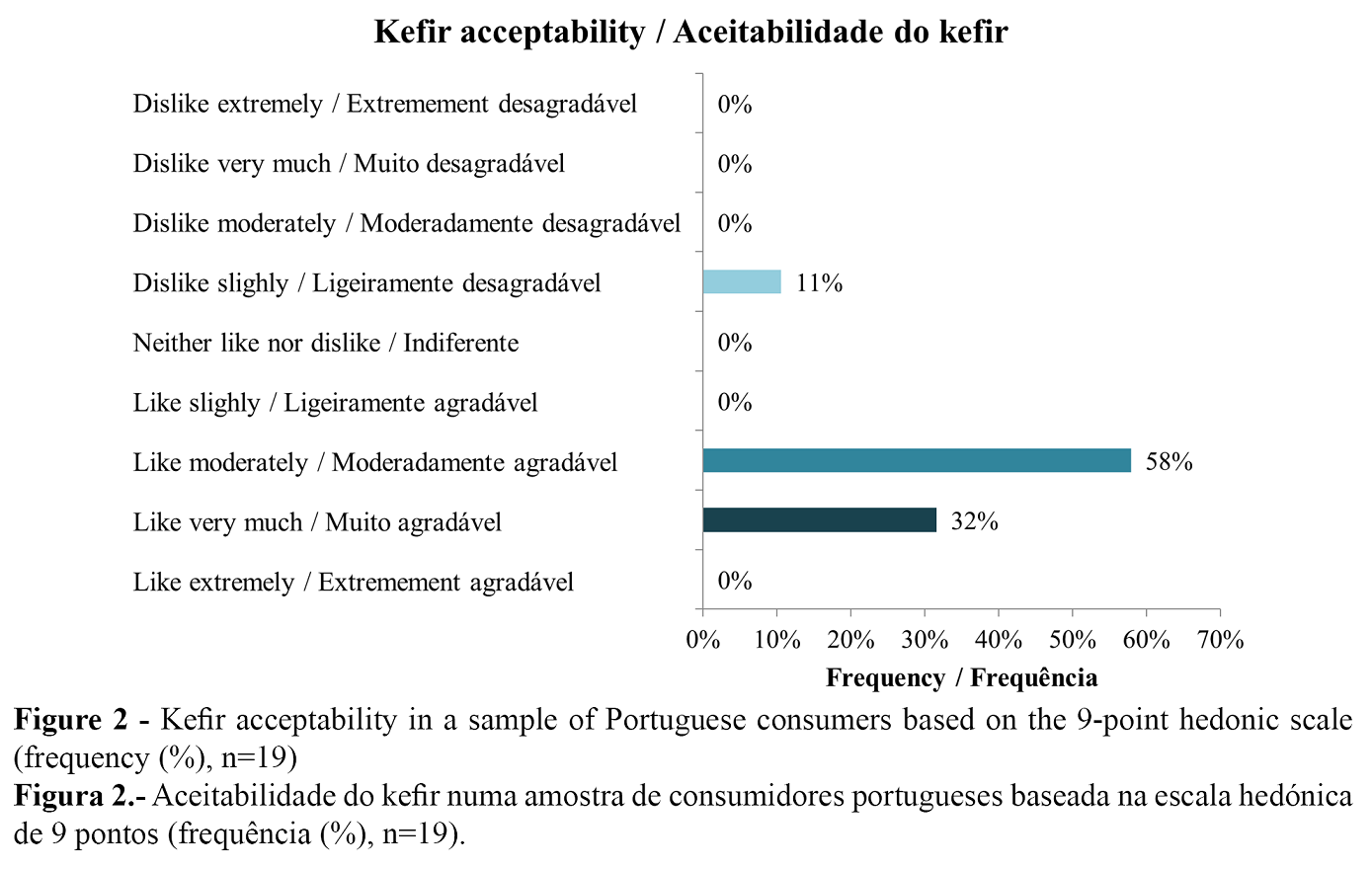![]()
Biopharmaceutical Sciences, Biomed Biopharm Res., 2021; 18(1):83-91
doi: 10.19277/bbr.18.1.252; download pdf verion [+] here
Acceptability of kefir produced by fermentation of Portuguese milk with CIDCA AGK1 grains in a sample of Portuguese consumers
Emília Alves, Patrícia Rijo, Luís Monteiro Rodrigues, Catarina Rosado*
CBIOS – Universidade Lusófona's Research Center for Biosciences and Health Technologies, Av. Campo Grande 376,
1749-024 Lisbon, Portugal
*corresponding author:
Abstract
Fermented foods, such as kefir, tend to be characterized by their unique flavor and aroma. Sensory perception of this type of food or beverage is a key factor for the general consumer acceptance of the product, which can be assessed through sensory tests. Conventional sensory tests include acceptance tests where consumers, not trained panelists, are asked to express their degree of like on a hedonic scale, where the level of acceptability of foods does not require a choice between alternatives. The most commonly used scale for testing consumer acceptability of foods is the 9-point hedonic scale. An average score of 7 or higher on the acceptability test indicates a high sensory quality and represents a good acceptance of the product by the panel. This study aimed to evaluate the acceptance of a kefir drink in a sample of Portuguese consumers. The acceptability test of the kefir obtained by fermentation of Portuguese milk with CIDCA AGK1 kefir grains was conducted in a group of 19 consumers using a 9-point hedonic scale and produced a mean score of 7.00 ± 1.15, which correlates with a qualitative rating of “Like moderately.” This work is part of an ongoing study, designated DermapBio, conducted by our research center, with an aim to evaluate the benefits of kefir ingestion for cutaneous health.
Keywords: Kefir, fermented dairy, sensory perception, acceptability test, hedonic scale
Received: 17/11/2020; Accepted: 20/02/2021
Introduction
Kefir is a unique fermented, slightly carbonated, dairy beverage known for its organoleptic characteristics. It originated from the Caucasus, and has been traditionally consumed for centuries in several countries in Eastern Europe (1). Traditional production uses kefir grains as a natural starter, which differentiates this beverage from other fermented milk (2). Kefir can be made from different kinds of milk (cow, goat, sheep, camel, buffalo) and is characterized by an acid and slightly yeasty taste which, combined with the carbon dioxide produced by the yeast flora, confers a prickly sensation that can be considered as its typical flavor (3). Fermented foods, such as kefir, tend to be characterized by their unique flavor and aroma (3). Sensory perception of this type of food is a key factor for the general consumer acceptance of such products, and can be assessed by sensory tests (4,5). In the food industry, sensory evaluation methods used in dairy products include affective or consumers tests, among others (6). By definition, these tests are applied only to a naïve (untrained) panel, since trained panels are potentially more critical and more sensitive than the average consumer, thus ceasing to be considered a typical consumer assessment (4). Affective tests are used to assess consumer likes and dislikes, and the most typical are preference tests and acceptance tests (5,7). In preference tests, consumers are presented with several samples and are required to choose between them, that is, a preference must be indicated. In acceptance tests, also called degree of liking, consumers are asked to indicate the degree of liking on a scale where the degree of acceptability of foods does not require a choice between alternatives (4,7). The most commonly used scale for testing consumer acceptability of foods is the 9-point hedonic scale (8-12). This scale can be presented numerically or verbally, horizontally or vertically, although such structural variations have no critical effect on the results (13). It is a bipolar scale with four positive and four negative categories on each side of a neutral center. The hedonic scale uses the anchors like and dislike, thus assuming a continuum degree of affection in the consumers’ preferences which can be categorized based on the like/dislike answers. This approach provides information on the product in a broader sense then a simple choice of yes or no (7,13). In rating scales, the selection of the anchor words must be meaningful and clear to the participants, must be related to the specific scale, and must prevent misinterpretation. Scoring in these scales is used with the main purpose of determining the magnitudes of the differences identified (14). In the 9-point hedonic scale, answers are usually assigned values between 1 and 9, where a value of 1 correlates with “dislike extremely” and a value of 9 with “like extremely”. Using this score, a mean value of 7 or higher is usually indicative of a high sensory quality, resulting in a good acceptance of the product (7, 15). When compared to other scaling methods, this scale is a robust way of estimating consumer like due to its simple yet sensitive categories of discriminating power. Its limited number of options also makes it suitable and easy to use for both trained or untrained panelists, thus justifying its wide acceptance (8,14,15). Therefore, when the primary objective of a study is to predict consumer acceptance, the 9-point hedonic scale has proven to be a simple and effective measuring device (8). Based on the fact that the consumption of kefir is not a typical food habit of the Portuguese population, this study aimed to evaluate the acceptance of this beverage in a sample of Portuguese consumers. This work is framed by a study regarding the cutaneous health benefits of kefir intake currently being conducted by our research team and designated as DermapBio .
Materials and Methods
Kefir beverage was prepared by fermenting semi-skim ULHT Portuguese cow’s milk (purchased at a local supermarket) using CIDCA AGK1 kefir grains for 24 hours at 20 °C. CIDCA AGK1 kefir grains were obtained from the Centro de Investigacíon y Desarrollo en Criotecnologia de Alimentos (CIDCA), La Plata, Argentina. The microbiological characterization of these grains has been described elsewhere (16-18). All volunteers were recruited from the DermapBio study conducted at our research centre, thus being a convenience sampling. Due to the fact that this work is part of an in-use study where kefir was consumed, we considered this an exploratory study. The study protocol was submitted to and approved by the ethics committee of the School of Sciences and Health Technologies at Lusofona’s University (Nº1/2018, 15th May 2018) and was conducted according to the principles of the Helsinki Declaration. The prepared kefir was evaluated by a consumer panel using 9-point hedonic scale. The consumer group consisted of 19 volunteers, 94.7% women and 5.3% men, aged 19 to 55 years (mean age 29.11 ± 11.61 years). The volunteers had no prior experience with kefir consumption. All volunteers were given a white plastic cup with a sample (100 mL) of freshly made kefir, under controlled conditions, and then were asked to grade the beverage in a 9-point hedonic scale, where the acceptability of the product was evaluated within a score of 1 (dislike extremely) to 9 (like extremely), according to overall acceptability of the product. The scale was presented to the volunteers as a Google form questionnaire (Figure 1). Results were expressed as mean ± standard deviation (SD) or as relative frequency (%), and association between variables was performed with Pearson’s Chi-Square Test using SPSS statistical package version 25 (SPSS Inc., Chicago, IL, USA).

Results
The group of volunteers who participated in the study was characterized socio-demographically (Table 1). Within the study group, 78.9% were university students, 68.4% lived in an urban area, and the majority had no smoking habits (78.9%). The average Body Mass Index (BMI) of the sample was 21.82 ± 2.89 kg/m2. The consumption of dairy products within the panel was mainly through the consumption of natural yogurt (84.2%), and 57.9% of the participants drank cow's milk regularly (Table 1). The results of the acceptability test using this 9-point hedonic scale showed that 58% of the volunteers assessed the kefir drink as “Like moderately”, 32% as “Like very much” and only 11% assigned the rating “Dislike slightly” (Figure 2). The average score given by this sample of volunteers to our kefir was 7.00 ± 1.15, which is correlates with a “Like moderately” rating, and the acceptability of kefir was not related to the consumption of dairy products, namely, consumption of milk or yogurt (p = 0.310 and p = 0.568, respectively).


Discussion
Our results, correlated with a “Like moderately” rating, seem to indicate a reasonable acceptance of kefir by our panel. A classification such as ours can be an indicator of a high quality sensory product (13). Our results were consistent with those obtained by Moretti et al. (14), in which the acceptability of kefir made with CIDCA AGK1 grains, was also tested using untrained panelists (n=93) and a 9-point hedonic scale. In their study, the average score obtained was 7.88 ± 0.35 and this result was correlated with a qualitative grade of “Like very much”, which indicated a good acceptance of the product by the panel (14).
The use of a 9-point hedonic scale has been widely accepted as a good tool to infer consumer acceptability as it is able to provide internal validity to the test (14). The use of this type of scale for assessment of consumer acceptability of dairy has been confirmed by other researchers (6,10,14). Nevertheless, some weak points have been identified, namely the small number of categories available, the lack of equal intervals between categories, the presence of the neutral category “neither like or dislike” that lessens the scale efficiency, and the general consumer tendency to avoid using the extreme categories, which may increase the scale vulnerability to ceiling effects (7,11,19). A consideration must be made about the use of a scale that was translated to Portuguese language. As demonstrated by Curia et al. (20) regarding the Spanish language, the use of the 9-point hedonic scale in languages different from English must be done with caution, as the general population may fail to perceive the translations with the same meaning as they have in English, especially with regard to the extreme categories of the scale (20). To the best of our knowledge, the translation of this scale into Portuguese has not yet been validated and, as such, care should be taken in generalizing the conclusions drawn. It should be noted that acceptance tests (consumer liking tests) should preferably be carried out with a larger number of individuals (6). Some authors recommend 50 consumers as the minimum desirable to guarantee the accuracy of the statistical analysis and to be able to draw conclusions product acceptance (not applicable to trained tasters) (5,6,8). Furthermore, because we used a convenience sample of volunteers already willing to participate in a study involving kefir consumption for eight weeks, the main disadvantage of which is the lack of clear generalization (21), we cannot extrapolate our results to the general population. Therefore, due to the type of sampling and the limited number of consumers used in our study, we cannot fully infer about the acceptability of kefir for Portuguese consumers. Nevertheless, these results can provide an indication of how the product is viewed by consumers with no previous contact with this beverage. Hedonic opinions, such as food choice, are affected by environmental context and individual expectations (22,23). Both the intra- and the inter-variability of consumers may influence the product acceptance throughout time (7,22,23). In general, the individual like/dislike stimuli may be influenced by environment, for example, type of meal, time of day, number of times the food has been consumed recently or temperature of the food, thus increasing the difficulty of measuring a stable attitude toward a certain food (7,24). As stated by Lawless & Heymann (2010), habits, experiences, contexts and attitudes are important contributors to the actual consumption of a food in a specific situation (7). Since the participants in our study were all part of the same group and so, were not blind to kefir consumption, this factor may have influenced the individual choices of the volunteers, despite the fact that the scale was presented to each participant individually. Nevertheless, these results support the adoption of the protocol applied to our in-use "DermapBio" study of the impact on the skin health of kefir consumption conducted by our research team, as during the study this beverage must be taken daily.
Conclusion
General consumer acceptance of fermented foods, such as kefir, that are characterized by their unique flavor and aroma are mainly dependent of their sensory perception. Although kefir is not traditionally consumed in Portugal, our kefir drink showed a good acceptance in this sample of consumers and supports the protocol adopted in a posterior study.
Author Contributions Statement
PR, CR, LMR, and EA conceptualization and study design; EA experimental implementation; EA and CR data analysis; EA illustrations; EA, PR and CR drafting editing and reviewing
Funding
This work is financed by national funds through the FCT - Foundation for Science and Technology, I.P., through projects UIDB/04567/2020 and UIDP/04567/2020 to CBIOS.
Conflict of Interests
The senior editors co-authoring this manuscript had no participation in the review nor in the decision process.
All authors have declared there were no financial and/or personal relationships that may present a potential conflict of interest.
References
- Farnworth, E.R. (2005).Kefir—A complex probiotic. Food Science and Technology Bulletin: Functional Foods, 2, 1-17. doi:10.1616/1476-2137.13938.
- Simova, E., Beshkova, D., Angelov, A., Hristozova, Ts., Frengova, G., Spasov, Z. (2002).Lactic acid bacteria and yeasts in kefir grains and kefir made from them. Journal of Industrial Microbiology and Biotechnology,28(1), 1-6. doi:10.1038/sj/jim/7000186.
- Irigoyen, A., Arana, I., Castiella, M., Torre, P., Ibañez, F.C. (2005).Microbiological, physicochemical, and sensory characteristics of kefir during storage. Food Chemistry, 90, 613–620. doi:10.1016/j.foodchem.2004.04.021.
- Drake, M.A. (2007). Invited Review: Sensory Analysis of Dairy Foods. Journal of Dairy Science, 90, 4925–4937. doi:10.3168/jds.2007-0332.
- Lawless, H.T., Heymann, H. (1999). Consumer field tests and questionnaire design. In H.T. Lawless, H. Heymann (Eds.), Sensory Evaluation of Food, 1st Ed. (pp 480–514). New York, NY: Chapman and Hall.
- Moskowitz, H. R., Beckley, J. H., & Resurreccion, A. V. A. (2012). Sensory and Consumer Research in Food Product Design and Development (H. R. Moskowitz, J. H. Beckley, & A. V. A. Resurreccion (eds.); 2nd ed.). Wiley-Blackwell.
- Lawless, H.T., Heymann, H. (2010). Acceptance Testing. In H.T. Lawless, H. Heymann (Eds.), Sensory Evaluation of Food(pp. 325-344). doi:10.1007/978-1-4419-6488-5_14.
- Lim, J. (2011). Hedonic scaling: A review of methods and theory. Food Quality and Preferences, 22, 733–747. doi:10.1016/j.foodqual.2011.05.008.
- Illupapalayam, V. V., Smith, S. C., & Gamlath, S. (2014). Consumer acceptability and antioxidant potential of probiotic-yogurt with spices. LWT - Food Science and Technology,55(1), 255–262. https://doi.org/10.1016/j.lwt.2013.09.025
- Cruz, A. G., Walter, E. H. M., Cadena, R. S., Faria, J. A. F., Bolini, H. M. A., Pinheiro, H. P., & Sant’Ana, A. S. (2010).Survival analysis methodology to predict the shelf-life of probiotic flavored yogurt. Food Research International,43(5), 1444–1448. https://doi.org/10.1016/j.foodres.2010.04.028.
- Schutz, H.G., Cardello, A.V. (2001). A labeled affective magnitude (LAM) scale for assessing food liking/disliking. Journal of Sensorial Studies,16, 117–159.
- Stone, H., Bleibaum, R.N., Thomas, H.A. (2012). Measurement. In H. Stone, R.N. Bleibaum & H. Thomas (Eds.). Sensory Evaluation Practices(pp. 81–115). doi:10.1016/b978-0-12-382086-0.00003-0.
- Everitt, M. (2009). Consumer-targeted sensory quality. In G. Barbosa-Cánovas, A. Mortimer, D. Lineback, W. Spiess, K. Buckle, & P. Colonna (Eds.). Global issues in food science and technology(pp. 117–128). doi: 10.1016/B978-0-12-374124-0.00008-9.
- Moretti, A.F., Gamba, R.R., Costa, M., De Antoni, G., Peláez, Á.L. (2019).Protective Effect of Lyophilization on Fermentative, Microbiological and Sensory Properties of Kefir. International Journal of Biochemistry and Pharmacology, 1(1), 5-11. doi: 10.18689/ijbp-1000102.
- Van Trijp, H.C.M., Schifferstein, H.N.J. (1995). Sensory analysis in marketing practice: comparison and integration. Journal of Sensorial Studies, 10, 127–147. doi.org/10.1111/j.1745-459X.1995.tb00010.x.
- Garrote, G. L., Abraham, A. G., & De Antoni, G. L. (2001).Chemical and microbiological characterisation of kefir grains. Journal of Dairy Research, 68(4), 639–652. https://doi.org/10.1017/S0022029901005210.
- Hamet, M. F., Londero, A., Medrano, M., Vercammen, E., Van Hoorde, K., Garrote, G. L., Huys, G., Vandamme, P., & Abraham, A. G. (2013). Application of culture-dependent and culture-independent methods for the identification of Lactobacillus kefiranofaciens in microbial consortia present in kefir grains. Food Microbiology, 1–33. https://doi.org/10.1016/j.fm.2013.06.022.
- Diosma, G., Romanin, D. E., Rey-Burusco, M. F., Londero, A., & Garrote, G. L. (2014). Yeasts from kefir grains: Isolation, identification, and probiotic characterization. World Journal of Microbiology and Biotechnology, 1–11. https://doi.org/10.1007/s11274-013-1419-9.
- Lim, J., Fujimaru, T. (2010). Evaluation of the labeled hedonic scale under different experimental conditions.Food Quality and Preference, 21, 521-530. https://doi.org/10.1016/j.foodqual.2010.02.001.
- Curia, A.V., Hough, G., Martinez, M.C., Margalef, M.I. (2001). How Argentine consumers understand the Spanish translation of the 9-point hedonic scale. Food Quality and Preference12, 217–221. doi: 10.1016/s0950-3293(01)00012-x.
- Bornstein, M. H., Jager, J., & Putnick, D. L. (2013). Sampling in developmental science: Situations, shortcomings, solutions, and standards. Developmental Review, 33(4), 357–370. https://doi.org/10.1016/j.dr.2013.08.003.
- Deliza, R., MacFie, H.J.H. (1996).The generation of sensory expectation by external cues and its effect on sensory perception and hedonic ratings: A review. Journal of Sensorial Studies, 11, 103–128. doi.org/10.1111/j.1745-459X.1996.tb00036.x.
- Schifferstein, H.J.N. (1995). Contextual shifts in hedonic judgment. Journal of Sensorial Studies,10, 381–392. doi.org/10.1111/j.1745-459X.1995.tb00027.x.
- Kahkonen, P., Tuorila, H., Hyvonen, L. (1995). Dairy fact content and serving temperature as determinants of sensory and hedonic characteristics of cheese soup.Food Quality and Preference,6, 127–133. doi.org/10.1016/0950-3293(95)98555-W.
